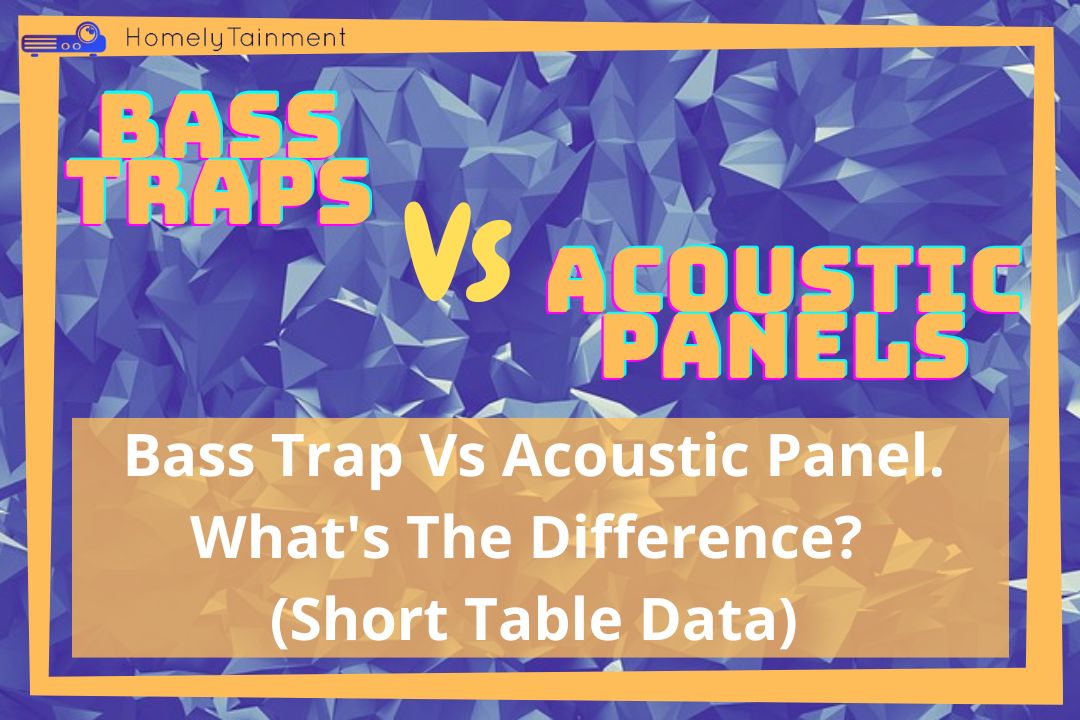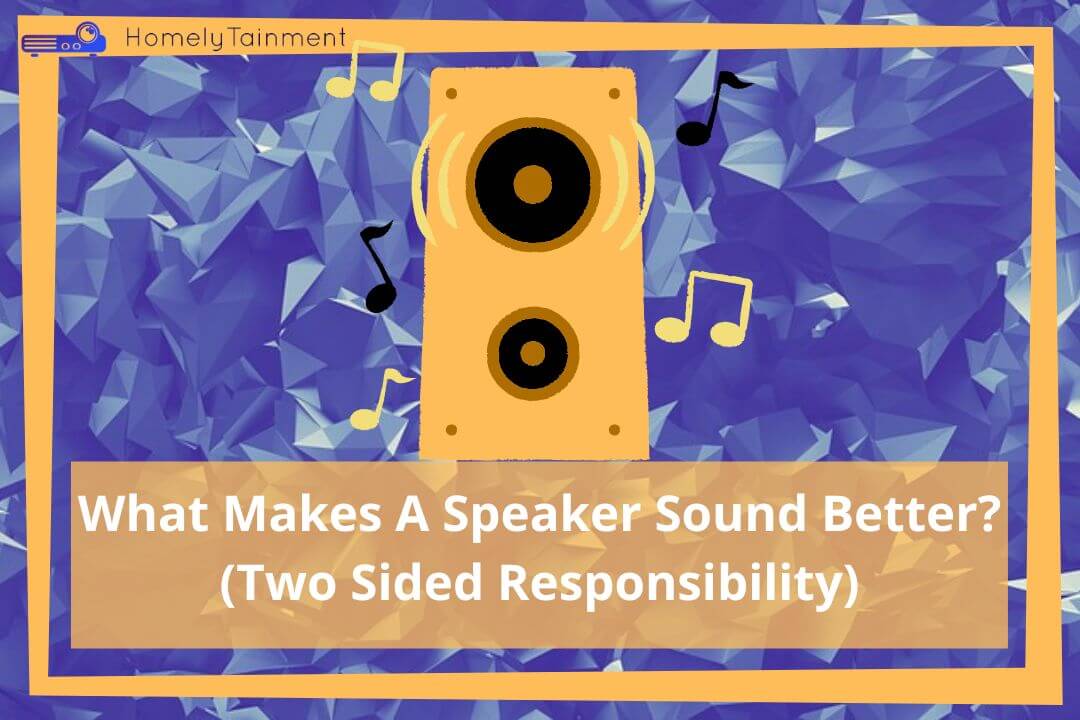
Homelytainment earn commissions (at no additional cost to you) if you purchase products from retailers after clicking on a link from our site.
The bass traps and acoustic panels both are used to acoustically treat the home theater. They have similar jobs but their purpose is different. This guide is created to understand the basic difference between them with short table data and charts.
I have given so much time to the acoustic treatment and have written articles about it on my site. That’s why I received an e-mail from some folks. They wanted me to clearly tell them the difference between these two products. That’s why today I wanted to write a guide about it.
I will also answer some of the most asked questions related to this topic at the end of this article. You will know this topic inside out after reading this guide.
Bass Trap Vs Acoustic Panel. What’s The Difference?
| Bass Trap | Acoustic Panel |
|---|---|
| Absorb sound frequencies of 300 Hz and lower | Absorb sound frequencies from above 300 Hz to 20kHz |
| They are dense | They are thinner |
| They are used only in the corners | They are used on walls and ceilings |
Let’s discuss the main difference in short headings. The science behind them is explained here.
Different Application Areas For Different Frequency Ranges

As I have told you earlier in this guide that their purpose is different but the job is kinda similar.
Bass Traps: They work to absorb the bass frequencies. The bass frequencies are from 20 to 200 Hz but the lower midrange frequency (200 – 300 Hz) range nature is similar to that of bass frequencies.
These types of frequencies at the lower end of the spectrum behave like water waves. They travel in a circle shape in the room. These waves when colliding with the corners bounce back and create a buildup with the fresh frequencies coming to the corners.
That’s why the bass at the corners of the home theater sounds distorted and it sounds completely fine in the middle of the room. That’s why the bass traps are installed at the corners to absorb the excessive bass frequencies. That’s why they can’t create a frequency build-up at the corners and the bass feels the same everywhere in the room. Read to know. Do you need bass traps in every corner? I have provided budget-friendly ways in this guide.
Acoustic Panels: The higher frequencies than the 300 Hz behave differently and therefore we need acoustic panels for those frequencies to absorb the excessive amount of it. Keep reading to know their nature.
Different Placement Areas
Bass Traps: They are for those frequencies which behave like water waves and spread in such a manner. That’s why they are installed at the corners because the frequencies build up there.
Acoustic Panel: The higher frequencies travel in the form of rays. They collide with ceilings, floors, and walls in the form of rays and bounce back. In this way, they collide all over the room. That’s why you hear your sound echo. The echo might be hard to identify at once but the same dialogue first hits you when the rays travel right at you. After that dialogues bounce back and hit your ears from another side with a milliseconds delay. This delay can be sensed by the human brain and it will confuse the brain.
Now, you might have this question in your mind. You install acoustic panels on walls and ceilings but what about the floor? You will have to arrange a dense rug or carpet to place on the floor with dense seating for the audience.
Different Shapes And Densities
Bass Trap: They usually look like a fine 3D triangle. They are very dense in the middle because the lower frequencies have more energy than the higher frequencies. That’s why to absorb them better you need a deeper material. Otherwise, they can travel a lot better than the higher frequencies and this will lead to frequency buildup and reverberation.
Acoustic Panels: They have different shapes but the most used one is a square shape. They are less dense because they have to be installed in many first reflection points of the sound and also the higher frequencies have lesser energy. Know from this guide how to identify these first reflection points. Where to install acoustic panels? I have provided simple steps to do.
Final Verdict
The bass traps and acoustic panels are both used for acoustic treatment but the bass traps work to absorb bass frequencies at the lower end of the frequency spectrum and the acoustic panels work to absorb mid to high-end frequencies of the frequency range.
Find answers to your questions related to acoustic panels. I have answered the most important questions in this FAQ post.
Did you get something out of this Bass Traps Vs Acoustics Panels guide? Hold On We Have Something Exciting To Share.
[the_ad id=”4771″]FAQs
Can I use acoustic panels as bass traps?
You can use acoustic panels as bass traps, but you will have to stick 2-3 acoustic panels in place of one bass trap. Because the bass trap needs to be denser because they deal with more energetic frequencies than the acoustic panels.
The bass traps are denser and the acoustic panels are thinner. That’s why you will have to use 2-3 acoustic panels in place of one bass trap.
How do you know if you need bass traps?
You can find this with the help of your ear or with an SPL meter. Just send a test tone from the receiver sound setting to the subwoofer and move around the corners if you feel the bass is stronger in a few corners then you need bass traps.
You can repeat the same with an SPL meter. Hold the SPL meter in your hand and send test tones from the subwoofer. Move around the room and see in which corners you see higher decibels of bass on the screen of the meter.
Do bass traps improve sound quality?
The bass traps do improve the sound by eliminating distortion and reverberation from the bass sound. The frequency build-up contributes to the distortion in the sound and the bass frequencies move further in the room, contributing to reverberation.
Bass traps filter the sound by absorbing the bass frequencies and stopping them from traveling further. The same case goes for the acoustic panels. The acoustic panels improve the sound, in the same manner, that’s why I don’t want to repeat the same answer.
Helpful Resources For The FAQs To Read More
- This was my opinion, read more about it from this AVsforum discussion thread. (resource of the third answer)
- This was my opinion. Know more about it from this youtube video. (Resource for the first answer)




